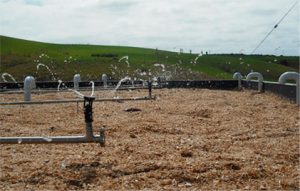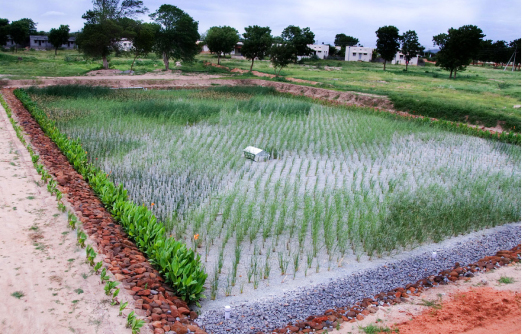
OPERATING PRINCIPLE

DESCRIPCIÓN
The vermifilter BIDATEK® is a revolutionary biological system for wastewater treatment that combines sewage treatment with the degradation of the pollution retained during the treatment, thanks to the action of an earthworm population (eisenia foetida).
The biological technology BIDATEK®, distinguished itself by being ZERO WASTE, as the treatment process does not generate sludge. On the contrary, pollution is transformed into worm humus that may be used as agricultural fertilizer.
 1st prize “Cleantech Open Silicon Valley 2011” in San Francisco (USA)
1st prize “Cleantech Open Silicon Valley 2011” in San Francisco (USA)
From over 1,000 innovations in the field of CleanTechs from 23 different countries.
CHARACTERISTICS
Vermifilter BIDATEK® technology belongs to the family of biofilm processes or biomass solid support processes, but it marks a change in the concept of sewage treatment, as it transforms a waste product (wastewater) into three resources (treated water, organic fertilizer and worms). This represents a perfect example of “circular economy” transforming waste into valuable byproducts.
The effluent comes out by the bottom of the filter, with a percentage of BOD elimination higher than 80%. Besides, the pollution retained is degraded transforming into worm humus, suitable to be used as natural fertilizer. Consequently, an advantage of the filter is that it does not generate unstable sludge and transforms contamination into natural fertilizer. To understand the operation and the characteristics of our BIDATEK® technology, videos and photographs are available on our webpage.
A fine grain substrate in used as support, where the biomass is fixed together with an earthworm “eisenia foetida“ population. The functioning of the system consists in spraying the wastewater on the top filter surface; water runs through the filter layers and pollution is retained in the substrate and digested by the earthworms and the existing microbiology, without any need for reagents or consumables.


VERMIFILTER CONSTRUCTION
The construction of the tank where the layers of the vermifilter are placed may be done by two techniques:
OPTION 1: VERMIFILTER IN CONCRETE
Concrete tank (walls and floor).

OPTION 2: HALF BURIED VERMIFILTER
Walls in HDPE sheet and floor in reinforced concrete.

WATER DISTRIBUTION SYSTEM
The pre-treated wastewater is pumped to the top part of the vermifilter and homogeneously distributed through the whole surface of the vermifilter with Bidatek irrigation systems “BIDA-RIEG Pivoting-Central” or “BIDA-EXCEN Multipoint).
BIDA-RIEG PIVOTING-CENTRAL

BIDA-EXCEN MULTIPOINT

APPLICATIONS
- SEWAGE WATERS.
- MEAT INDUSTRY.
- BEVERAGE INDUSTRY.
- FOOD CANNING INDUSTRY.
- OTHER FOOD INDUSTRIES
ADVANTAGES
- 1. Low operational costs:
BIDATEK® technology has low energetics requirements as it does not need mechanical aeration and does not have expenses associated to sludge generation. - 2. Robustness of operation:
Its configuration as an extensive biofilter makes it capable of withstanding flow and pollutant load variations caused by seasonality or productive changes. - 3. A technology without waste generation (ZERO WASTE):
The biological technology BIDATEK® distinguished itself by being ZERO WASTE, as the treatment process does not generate sludge.On the contrary, pollution is transformed into worm humus, byproduct that can be used as agricultural fertilizer.
SUSTRATOS VERMIFILTRO
El vermifiltro BIDATEK® se compone de distintos sustratos seleccionados para conseguir el tratamiento del agua y la degradación de los sólidos.
Para la construcción del vermifiltro se utilizan los siguientes rellenos:
- Soporte aireación BIDA-AIR
- Sustrato drenante BIDA-BOX
- Sustrato filtrante BIDA-FILTER
- Sustrato soporte BIDA-CELL
La elección de los sustratos y las cantidades de éstos, está relacionada con los caudales y cargas de agua tratar, y serán definidas de forma personalizada para las necesidades del cliente.
SUBSURFACE FLOW CONSTRUCTED WETLANDS

OPERATING PRINCIPLE
Artificial wetlands are natural treatment systems formed by lagoons or shallow channels, filled with gravel and sand, where aquatic vegetation is planted. In these systems, decontamination procedures take place through the interaction among water, filtering fillers, microorganisms and vegetation.
CHARACTERISTICS
In the subsurface flow constructed wetlands the wastewater flows under the ground through a granular medium in contact with the roots and rhizomes of the plants. The depth of the water sheet is usually between 0.3 and 0.9 m. The biofilm grows adhered to the granular medium, roots and rhizomes of the plants and plays a fundamental role in the processes of water decontamination.
Subsurface flow wetlands can be further classified as horizontal flow or vertical flow constructed wetlands.
SUBSURFACE HORIZONTAL FLOW CONSTRUCTED WETLAND
The water flows horizontally through the granular medium and the rhizomes and roots of the plants. The depth of the water is between 0.3 and 0.9 m. This kind of wetland works permanently flooded (water is found between 0.05 and 0.1m below the surface) and with loads of around 6 g BOD/m2/day.

SUBSURFACE VERTICAL FLOW CONSTRUCTED WETLAND
This kind of wetland was developed as an alternative to horizontal wetlands in order to produce nitrified effluents. Vertical systems are generally combined with horizontal systems, so nitrification and denitrification processes take place progressively, eliminating the nitrogen. Water flows vertical and is distributed by pulses, so that the granular medium is not permanently flooded. The depth of the granular medium is between 0.5 and 0.8 and they operate with loads of around 20 g BOD/m2 per day.
Vertical systems have a greater capacity of treatment than the horizontal ones (they require less surface to treat a certain organic load). On the other hand, they are more susceptible to clogging.


BENEFITS
Subsurface Constructed Wetlands are ecological wastewater treatment systems.
- Low operating costs.
- Simple operation and maintenance.
- Does not require chemical reagents.
- Low sludge production.
- Simple construction.
APPLICATIONS
Applications for this type of wastewater treatment plants:
- Urban centres, up to 10,000 inhabitants
- Hotels, resorts and other tourist facilities
- Small agro-food industries
BIDATEK ECOLOGICAL SOLUTIONS
BIDATEK offers engineering services for the design of treatment plants equipped with both:
- SUBSURFACE VERTICAL FLOW CONSTRUCTED WETLAND.
- SUBSURFACE HORIZONTAL FLOW CONSTRUCTED WETLAND.
- Implementation of the wetland vessels, land or gabion excavation.
- Installation of different waterproofing solutions for wetlands, from HDPE, PVC or EPDM sheet and polypropylene or polyester geotextiles.
- Placement of drainage fillings, gravels with different grain size, plastic cells, slags, etc.
- Installation of air ventilation elements.
- Installation of water input and distribution net.
- Installation of water regulation and evacuation net.

Vaso de humedal
ejecutado en gaviones

Instalación de lámina PEAD

Vaso de humedal ejecutado en hormigón
y utilización de celdas plásticas drenantes.

Tratamiento de aguas industriales.


OTRAS TECNOLOGÍAS NATURALES PARA EL
TRATAMIENTO DE AGUAS:
- Plantas de lagunaje anerobio y/o facultativo.
- Plantas de lagunaje facultativo y maduración.
- Vermifiltros.
Av. Alcalde José Elosegui, 43
Donostia-San Sebastián 20013
Gipuzkoa – SPAIN
